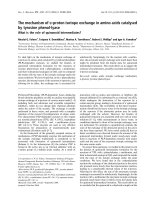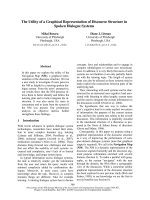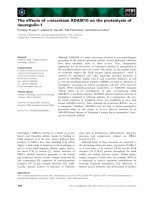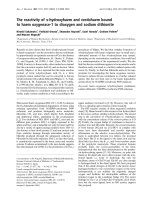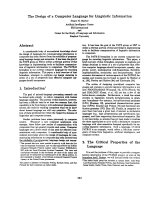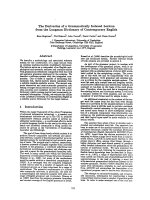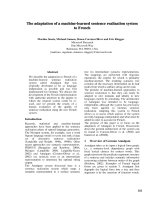Báo cáo toán học: "The arc-width of a graph" ppsx
Bạn đang xem bản rút gọn của tài liệu. Xem và tải ngay bản đầy đủ của tài liệu tại đây (100.85 KB, 8 trang )
The arc-width of a graph
J
´
anos Bar
´
at
∗
and
P
´
eter Hajnal
†
Bolyai Institute
University of Szeged
Aradi v´ertan´uk tere 1.
Szeged, 6720 Hungary
Submitted: January 23, 2001; Accepted: June 13, 2001.
MR Subject Classifications: 05C62, 05C83
Abstract
The arc-representation of a graph is a mapping from the set of vertices to the arcs
of a circle such that adjacent vertices are mapped to intersecting arcs. The width
ofsucharepresentationisthemaximumnumberofarcshavingapointincommon.
The arc-width(aw) of a graph is the minimum width of its arc-representations. We
show how arc-width is related to path-width and vortex-width. We prove that
aw(K
s,s
)=s.
1 Intro duction
The notation and terminology of the paper follows [2].
In the Graph Minors project Robertson and Seymour (often with other co-
authors) introduced several minor-monotone graph parameters. We recall their
first such parameter. Our definition is a dual to the original one appearing in [3].
About the equivalence, see e.g. Exercises 24, 25 in Chapter 12 of [2].
Definition 1 The interval-representation of a graph G is a mapping φ from its
vertex set to the intervals of a base line, such that adjacent vertices are mapped to
intersecting intervals. The width (in a representation) of a point P of the base l ine
is the number of intervals containing P .Thewidth of φ is the maximum width
∗
Research supported by OTKA Grant T.34475. and the Hungarian State E¨otv¨os Scholarship
†
Research supported by OTKA Grants T.30074. and T.34475.
the electronic journal of combinatorics 8 (2001), #R34 1
of the points of the base line. (This is equa l to the maximum number of pairwise
intersecting intervals.) The interval-width of a graph G is the minimal possible
width of such interval-representations, pw
∗
(G) in notation.
Actually, Robertson and Seymour defined path-width(pw), which is one less than the
above defined interval-width. They extended the notion of path-width by changing
the base line to a tree, and substituting intervals with subtrees. (This is still the
dual, not the original definition.) The new parameter thus obtained is the tree-
width of a graph. We take another route for extension. We substitute the base line
with a base circle:
Definition 2 The arc-representation of a graph G is a mapping from the vertex
set V (G) to the set of arcs of a base circle, such that adjacent vertices of G are
mapped to intersecting arcs. The width (in a representation) of a point P of the
base circle is the number of representing arcs containing P .Thewidth of is the
maximum width of the points of the base circle. (This is not the maximum number
of pairwise intersecting arcs.) The arc-width of a g raph G is the minimal possible
width of such arc-representations, aw(G) in notation.
Our base circle will be the unit circle on the coordinate-plane, i.e. the set of points
(cos x, sin x), where x ∈ [0, 2π). An arc is a connected subset of the circle. It is
easy to see that the notion of arc-width is not changed if we insist on representing
vertices with closed arcs. We also assume that all the representing arcs are proper
subsets of the circle. Fixing the clockwise orientation of the circle, each arc has a
unique starting and ending point. Let arc(x
1
,x
2
) denote the closed arc starting at
(cos x
1
, sin x
1
) (the left endpoint of the arc) and ending at (cos x
2
, sin x
2
) (the right
endpoint of the arc). In this way, points on the circle and their corresponding angles
are naturally identified. For an arc-representation of G, the left endpoint of the
arc representing u is denoted by l(u), and the right endpoint is denoted by r(u),
i.e. (u)=arc(l(u),r(u)).
It is easy to prove the minor-monotonicity of the newly introduced graph pa-
rameter.
Lemma 3 Arc-width is minor-monotone. ✷
2 Connections to other graph parameters
Robertson and Seymour proved that any graph without H as a minor can be ob-
tained by clique sums from graphs that can be “nearly drawn” in a surface Σ − k
H
(where Σ is any closed surface such that H can not be drawn in it, and k
H
is a
suitable integer). This theorem extends their earlier results, when they established
similar structural theorems in the cases when H was a tree, respectively a planar
graph. This extension is crucial in the proof of the Graph Minor Theorem. To
measure how nearly a graph is drawn in Σ − k
H
, they introduced the notion of
vortex-decomposition in [4], see also [5]. Using their previous results on path-width,
Robertson and Seymour did not need to investigate this new parameter in depth
(in spite of its inherent naturalness).
the electronic journal of combinatorics 8 (2001), #R34 2
Definition 4 [5] Let G be a graph, and let U be a cyclic ordering of a subset of its
vertices. We say that (X
u
)
u∈U
is a vortex-decomposition of the pair (G, U) if
(V 1) u ∈ X
u
for every u ∈ U,
(V 2)
u∈U
X
u
= V (G), and every edge of G has both ends in some X
u
,
(V 3) for every vertex v ∈ V (G),thesetofallu ∈ U with v ∈ X
u
is a contiguous
interval (the empty set, or the whole U are possibilities).
We say that (X
u
)
u∈U
has width k,if|X
u
|≤k for every u ∈ U .
The vortex-width of G (denoted by vw(G)) is the minimum width taken over all
vortex-decompositions of G.
Lemma 5 aw(G)=vw(G).
Proof: We construct a vortex-decomposition of G from an arc-representation of
G with the same width, and vice versa.
Assume first that there is a given arc-representation of G of width k.LetL
be the set of the points of the base circle being a left endpoint of some representing
arc. For each element ∈ L, choose a vertex v such that the corresponding arc (v)
starts at .LetU be the set of chosen vertices. Let X
u
:= {v : (v) ∩ l(u) = ∅}.
(V1) and (V3) are satisfied. An edge of G corresponds to two intersecting arcs
in . Moreover, if two arcs intersect, then they also intersect above a left endpoint.
Hence (V2) holds. The width is k by the definition of X
u
.
Assume now that a vortex-decomposition (G, U)ofwidthk is given. To each
element u ∈ U associate a point P
u
of the base circle, inheriting the cyclic order of
the vertices in U. By (V3) we can associate an arc to every vertex v as follows: if
v ∈ X
u
i
1
, ,X
u
i
s
∈ U (following the cyclic order), then l(v):=P
u
i
1
and r(v):=
P
u
i
s
in . In this way an arc-representation arises. The width of is k. ✷
Arc-width is a natural modification of interval-width (path-width). There is a
quantitative connection, not just a formal one. The next lemma shows that the two
measures are within a factor of 2.
Definition 6 Let w
min
and w
max
denote the minimum and maximum width of the
points in an arc-representation .Then is called a (u, w)-representation if and
only if u = w
min
() and w = w
max
().
Observe that w
max
() w
min
().
Lemma 7 Let be an arc-repres entation of G.Then
(i) pw
∗
(G) ≤ w
max
()+w
min
() and
(ii)
1
2
(pw
∗
(G)+1)
≤ aw(G) ≤ pw
∗
(G).
Proof: (i) Let i := w
min
(), j := w
max
(). There is a point x of the base circle
where the width is precisely i.Cutthebasecircleatx, and strengthen it to obtain
a line. In this way, the arcs not containing x become intervals. Substitute the arcs
containing x (there are i of them) with the whole line as a representing interval. We
produced an interval representation of G of width i + j.
(ii) The second inequality is trivial. The first one follows from (i). In the next
section, we exhibit examples showing that both bounds are sharp. ✷
the electronic journal of combinatorics 8 (2001), #R34 3
3 Special graph classes
Extending the base line to a base circle (Definition 1 → Definition 2) does not always
help in the representation.
Lemma 8 If T is a tree, then aw(T )=pw
∗
(T ).
Proof: If C denotes the base circle, and is a covering line of C,thenletp : → C
be the corresponding continuous projection. We prove by induction that we can
construct an interval-representation λ of T from an arc-representation of T ,with
the following properties:
–everyarc(v)ofC has a corresponding interval λ(v)on such that p(λ(v)) = (v),
– λ is an interval-representation of T ,
– the width of λ at a point P of is at most the width of at the point p(P )ofC.
Let us call such an interval-representation ‘good’.
If T is a single vertex, then we are easily done.
Assume now that the statement is true for any tree with at most k − 1 vertices.
Consider a tree T with k vertices. Delete a leaf v of T getting a graph T
with k − 1
vertices. Let u be the only neighbor of v.Let be an arbitrary arc-representation
of T , inducing an arc-representation
= |
T
of T
. By the induction hypothesis we
can obtain a good interval-representation λ
of T
based on
.LetP ∈ (u) ∩ (v).
There exists
P ∈ λ(u) such that p(
P )=P .Let(v) be an interval I of , containing
P , and intersecting none of the other intervals λ(w). Extending λ
with I as λ(v),
we obtain the desired good interval-representation of T . ✷
The condition on T is not necessary. There are other graphs satisfying aw(T )=
pw
∗
(T ). In general one expects aw(G) <pw
∗
(G), e.g. we can easily see the follow-
ing.
Lemma 9 aw(C
n
)=2and pw
∗
(C
n
)=3,whereC
n
is the cycle with n ≥ 3 vertices.
✷
The complete graphs exhibit the other extreme: their arc-width and their path-
width are as far as possible from each other. This is not difficult to prove, so we
omit the details.
Lemma 10 aw(K
n
)=
n
2
+1 ✷
The complete bipartite graph has much less edges. But surprisingly, its arc-width
is almost the same. We first give an arc-representation of K
s,s
of width s.Thenwe
prove that this arc-width is best possible for K
s,s
.
Lemma 11 aw(K
s,s
) ≤ s.
Proof: Let the two color-classes of K
s,s
be {x
1
, ,x
s
} and {y
1
, ,y
s
}.Consider
the following arc-representation of K
s,s
(ε denotes an arbitrarily small positive real
number):
a
1
= arc
−ε, (s − 2)
2π
s
+ ε
the electronic journal of combinatorics 8 (2001), #R34 4
b
1
= arc
ε,
2π
s
− ε
Let φ denote the clockwise rotation by
2π
s
,andφ
k
that the rotation φ is repeated
k times. Let (x
i
)=φ
i
a
1
,and(y
i
)=φ
i
b
1
. (x
i
) ∩ (y
j
) = ∅,so is an arc-
representation of K
s,s
. Counting the width of the points of the base circle we get:
width
2π
s
± ε
= s, otherwise width(x)=s − 1. ✷
Theorem 12 aw(K
s,s
)=s.
Proof: We have to prove w
max
((K
s,s
)) ≥ s for any arc-representation of K
s,s
.
Let the two color-classes G and B be called green and blue. F := {(v):v ∈ G};
this is a system, not necessarily a set. We call the elements of F green arcs. Let
the set of left respectively right endpoints of the arcs in F be denoted by L and R.
1. We may assume that the 2s endpoints are different, because this can be
reached with a small movement of the endpoints (without increasing the width).
2. We may assume that
I∈F
I = ∅. If this were false, then the width would
already be at least s.
3. We may assume that if I = J ∈F,thenI ⊂ J. If there were two arcs
I ⊂ J, then the endpoints would satisfy l(J) <l(I) <r(I) <r(J). Substitute I by
I
:= (l(J),r(I)) and J by J
:= (l(I),r(J)). The width did not change, and now
I
⊂ J
. Moreover, if any arc A intersects I (and hence J), then A intersects both
I
and J
,forI ⊂ I
and I ⊂ J
. Hence we still have a representation of K
s,s
.We
repeat this operation as long as we find two green arcs, one containing the other.
Our process will terminate, because the length of the longer arc after the change is
strictly less than the length of the longer arc before, and the possible length of the
arcs are determined by the possible 2s endpoints (hence finite).
4. Consider now the blue arcs. We may assume that they are minimal, i.e. we
cannot decrease them by maintaining the necessary intersections. Hence there are
only finitely many possible blue arcs (depending on the fixed green arcs). We call
these candidates. For an arc I ∈F, consider its candidate complementary arc I
which is defined as follows: l(I
):=r(I), and r(I
):=l(J), where J ∈Fis the
arc such that if I
intersects J,thenI
intersects every arc of F.Inthiswaywe
have defined a set system of arcs: F
:= {I
: I ∈F}. The correspondence I ↔ I
described above is a bijection. Moreover, the 2s endpoints of the arcs of F
are
exactly the same as the endpoints of the arcs of F. The left endpoints of the arcs
in F
are different. Hence we only have to show that two right endpoints cannot
coincide. Assume that l(I
1
) <l(I
2
)andr(I
1
)=r(I
2
). Then by 3 and the definition
of I
2
, r(I
2
) >l(I
1
), contradicting the definition of r(I
1
).
5. We consider now a special case, when the blue arcs are exactly the elements
of F
. Let us take all the arcs in F or in F
as disjoint arcs. Glue them together at
the common endpoints. This ‘snake’ covers the base circle s − 1 times. To see this,
consider a point, l(I)say,I ∈F. Cut the base circle at l(I) to get the non-negative
real line with l(I) = 0, and the natural < relation. l(I) ∈ J
if r(I) <r(J); l(I) ∈ J
if l(I) <r(J) <r(I), and for every J ∈F, J = I, exactly one case occurs.
In this special case we are done: each endpoint is covered by s arcs.
the electronic journal of combinatorics 8 (2001), #R34 5
6. From now on we consider the general case, when the blue arcs constitute an
arbitrary system of n arcs from F
.LetA ∈F
.Letµ(A) be the multiplicity of A
among the blue arcs.
The points of L and R divide the base circle into 2s open arcs. Let us call them
elementary arcs. We consider the width over an elementary arc, e say. There are
some arcs representing green vertices, which contain e. Moreover, there are some
candidate arcs A
1
, ,A
k
of F
containing e. There are multiplicities associated
with these arcs, say µ(A
1
), ,µ(A
k
) respectively. Assume there are q green arcs
containing e.LetF
e
denote the set of blue arcs containing e.From5weknowthat
q + |F
e
| = s − 1. If q +
A∈F
e
µ(A) >s− 1, then we are done. Otherwise we get the
following inequality:
A∈F
e
µ(A) ≤|F
e
|.
Observe that the number on the right-hand side is the number of terms on the
left-hand side.
7. For every elementary arc e, we define its successor e
∗
as follows. Cutting
the base circle at r(e), consider the first arc I
e
∈F, which is completely after r(e).
(Observe that ‘first’ is well-defined. If an arc starts first, it also has to end first
by 3.) There is an elementary arc beginning at r(I
e
), which is defined to be e
∗
.
Formally, l(e
∗
):= min
I∈F :r(e)/∈I
r(I).
8. Let us define a directed graph D. The elementary arcs are the vertices of D,
and the edges of D are of the form (e, e
∗
). More precisely, we define the edges to
be geometric objects, namely (e, e
∗
) is the arc of the base circle (in clockwise order)
fromthemiddleofe to the middle of e
∗
. Every elementary arc has out-degree one
in D, hence there is a directed circuit C in D.
9. The edges of C (glued together as in 5) cover the base circle homogeneously t
times. If we consider an arbitrary point P of the base circle, then there exist exactly
t edges of D going over P .LetI
∈F
be the first arc which is completely after
P .Everyedgef over P has a tail e such that e is an elementary arc disjoint from
I
. This is a consequence of the definition in 7. Also vice versa: if an edge f ∈ D
is not over P , then the tail e of f is an elementary arc which intersects I
.Wecan
interpret this result in another way: whenever we consider an arbitrary arc I
∈F
,
then the number of elementary arcs intersecting I
is a constant positive number, c
say.
10. Consider now the inequalities of 6 only for the vertices of C.LetV (C)=
{e
1
, ,e
p
}. Summing up all of these inequalities:
I∈F
e
1
µ(I) ≤|F
e
1
|
.
.
.
I∈F
e
p
µ(I) ≤|F
e
p
|
the electronic journal of combinatorics 8 (2001), #R34 6
————————————
e∈C
I∈F
e
µ(I) ≤
e∈C
|F
e
|.
By 9 the left-hand side is c
I
∈F
µ(I
). Hence by 6, the right-hand side is c · s.We
obtain the following:
c
I
∈F
µ(I
) ≤ c · s.
c is positive, so simplification gives:
I
∈F
µ(I
) ≤ s.
But we know that here equality holds. This is only possible if equality holds
everywhere in the above inequalities. Hence the width of the representation over an
elementary arc e ∈ C is exactly s − 1. Hence at the endpoint of an elementary arc
the width is at least s. ✷
4 Concluding remarks
We pointed out a natural graph parameter which had been neglected so far. Consid-
ering the arc-width we found challenging problems (like determining the arc-width
of K
s,s
). We hope that our work might lead to a better understanding of some
phenomena connected to the Graph Minor Theorem.
The results of Lemma 10 and Theorem 12 show that K
s,s
has much fewer edges
than K
2s
, but its arc-width is less only by one. Hence we ask the following:
Problem 13 How many edges of K
2s
can be deleted without decreasing the arc-
width?
Both inequalities of Lemma 7(ii) are sharp by Lemma 8 and Lemma 10. A natural
question is the determination of all extremal graphs:
Problem 14 Characterize the graphs G with prope rty aw(G)=pw
∗
(G), respec-
tively 2aw(G)=pw
∗
(G)+1.
Arc-width is minor-monotone, hence we can also ask the excluded minors of the
class aw(G) ≤ k. Such a list is similar to the one we get for path-width. By
Lemma 8 some of the elements of the two parallel lists are the same. It is known
that the number of excluded trees for pw(G) ≤ k grows superexponentially with
k. So finding complete lists is an enormous task even for small k. However the
following comparison is of interest:
Problem 15 Is the num ber of excluded minors for arc-width k always greater than
the number of excluded minors for interval-width k?
the electronic journal of combinatorics 8 (2001), #R34 7
We have seen in the proof of Lemma 7(i) that knowing the arc-width of a graph is
not sufficient for some arguments. The minimum width of the representation is also
necessary to be taken into account. The minimum-maximum width pair (mM)is
a refinement of arc-width which carries more information. This parameter is still
minor-monotone. An interesting property of mM is that disjoint union of graphs
appear among the excluded minors. For further results see [1].
We also wonder if there is any real-life usage of arc-width, similar to the appli-
cation of circular-arc graphs.
Acknowledgements
We would like to thank the editor-in-chiefs and the referee for valuable suggestions.
The first author is grateful for the hospitality of the Technical University of Den-
mark, special thanks for Robert Sinclair.
References
[1] J. Bar´at, Width-type graph parameters (PhD-Thesis), University of Szeged,
Hungary (2001)
[2] R. Diestel, Graph Theory (Second edition), Springer-Verlag, New York (2000)
[3] N. Robertson, P. D. Seymour, Graph Minors I. Excluding a forest, J. Combin.
Theory Ser. B. 35 (1983), 39-61.
[4] N. Robertson, P. D. Seymour, Graph Minors XVI. Excluding a non-planar
graph, manuscript (1996)
[5] R. Thomas, Recent Excluded Minor Theorems for Graphs, in Surveys in Com-
binatorics, 1999 267 201-222.
the electronic journal of combinatorics 8 (2001), #R34 8
